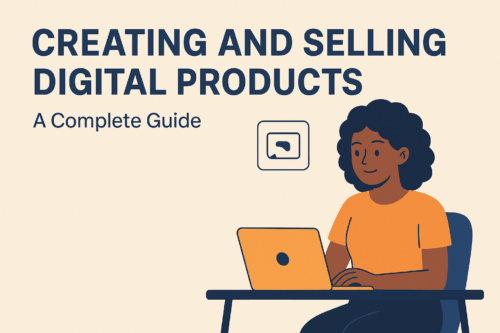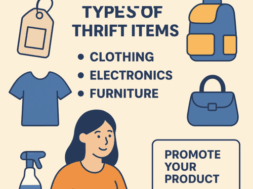E-commerce: Opportunities and Challenges in 2025

E-commerce has become one of the fastest-growing industries in the world, transforming how people buy and sell products and services. Unlike traditional retail, which requires a physical store, e-commerce allows entrepreneurs to reach customers globally with just a digital storefront.
In 2025, e-commerce continues to boom thanks to digital payments, mobile access, and innovative platforms. Entrepreneurs in Ghana, Africa, and across the globe have more opportunities than ever before to create successful online businesses. Whether it’s selling physical items like fashion and electronics or digital products like ebooks and online courses, the potential for growth is massive.
Selling Physical Products Online
Choosing the Right Niche
One of the first steps to success is identifying the right niche. Popular product categories include fashion, handmade crafts, electronics, and home décor. Choosing a niche with consistent demand but low competition gives new entrepreneurs a better chance of standing out.
Best Platforms for Beginners
For those just starting out, there are several beginner-friendly platforms:
- Amazon – A global giant with millions of active customers.
- Etsy – Ideal for handmade, creative, and unique products.
- Jumia – A fast-growing marketplace popular in Africa.
- Shopify – Offers customizable stores for building a brand.
Each platform has its strengths, and entrepreneurs can choose based on their target audience and resources.
Logistics and Delivery
Unlike digital products, physical products require effective logistics management. Packaging, delivery, and inventory play a crucial role in customer satisfaction. Partnering with reliable shipping companies like DHL, FedEx, and UPS, or using local delivery services, helps ensure smooth operations.
Marketing Strategies
To reach customers, sellers need strong marketing strategies. Social media platforms like Facebook, Instagram, and TikTok are excellent for promotions. SEO for product listings and influencer partnerships also help boost visibility and credibility.
Selling Digital Products Online
Popular Digital Products
Digital products are growing in demand because they are cost-effective to create and easy to distribute. Common examples include:
- Ebooks and guides
- Online courses and training programs
- Templates and digital planners
- Music, videos, and stock photos
Advantages of Selling Digital Products
Selling digital products comes with unique benefits:
- Low startup costs – No inventory or shipping.
- Scalability – Products can be sold to unlimited customers.
- Passive income potential – Once created, they generate ongoing revenue.
Platforms to Sell On
Several platforms make it easier to start selling digital products:
- Etsy digital downloads – For design files and creative products.
- Gumroad – A simple option for independent creators.
- Teachable/Udemy – Great for launching online courses.
Tools and Marketing
Content creation tools like Canva, Adobe Creative Cloud, and Notion simplify product design. To reach buyers, email marketing platforms like Mailchimp and targeted social media ads are highly effective.
Building an E-commerce Brand
Branding and Trust
In the crowded e-commerce space, branding is key. A strong brand tells a story, builds trust, and connects emotionally with customers. Secure payment gateways such as Stripe, Flutterwave, and Paystack add confidence for buyers, ensuring safe transactions.
Customer Loyalty
Retaining customers is just as important as attracting new ones. Providing excellent service, offering discounts, and creating loyalty programs help build long-term relationships.
Analytics and Trends
Analytics tools like Google Analytics and Shopify Insights give valuable data on customer behavior and sales performance. Looking ahead, trends like AI-driven personalization, live shopping experiences, and mobile-first stores are shaping the future of e-commerce in 2025.
Challenges in E-commerce
Competition
With more people entering the e-commerce space, competition is fierce. Differentiation through niche products and strong branding is essential.
Logistics and Fraud
Shipping delays and payment fraud remain major issues. Reliable delivery partners and fraud prevention measures are critical to protect both businesses and customers.
Costs and Consumer Behavior
Marketing costs, especially paid ads, can quickly add up. Entrepreneurs must balance expenses with profits while also adapting to changing customer behavior and expectations.
Practical Steps to Start an E-commerce Business
Step 1: Research and Choose Your Niche
Before starting, research what customers are buying and identify gaps in the market. Look at competitors, trending products, and customer reviews to find opportunities where you can add value.
Step 2: Select the Right Platform
Decide if you’ll use a marketplace (Amazon, Etsy, Jumia) or build your own store (Shopify, WooCommerce). Beginners often start with marketplaces, while long-term brand builders prefer customized stores.
Step 3: Set Up Secure Payments
Offering multiple payment options makes it easier for customers to buy. Platforms like Stripe, Flutterwave, PayPal, and Paystack enable smooth local and international transactions.
Step 4: Develop a Marketing Plan
Focus on building an audience with social media, SEO-optimized product listings, and content marketing. Paid ads on Facebook, Instagram, and TikTok can boost visibility, but organic community building offers long-term growth.
Step 5: Provide Excellent Customer Experience
From fast delivery to after-sales support, customer satisfaction drives repeat business. Happy customers often become your best marketers through reviews and referrals.
You can also read on: https://baobabentrepreneur.com/digital-services-opportunities-and-skills-for-the-future/
Future of E-commerce in Africa and Beyond
Mobile-First Shopping
In Africa, most online shoppers access stores via mobile phones. Businesses that optimize their platforms for mobile users will have a competitive edge.
Social Commerce Growth
Platforms like Instagram, Facebook Marketplace, and TikTok Shops are merging social media with e-commerce. This trend allows entrepreneurs to sell directly where customers spend their time.
AI and Automation
Artificial intelligence is transforming product recommendations, chatbots for customer service, and personalized marketing campaigns. In 2025, even small businesses can access affordable AI-driven tools.
Cross-Border E-commerce
African businesses are no longer limited to local markets. With improved logistics and digital payments, entrepreneurs can sell products internationally, expanding their revenue streams.
Green and Sustainable E-commerce
Eco-friendly packaging, ethical sourcing, and sustainable products are becoming strong selling points. Customers are increasingly supporting brands that align with their values.
Final Thoughts
E-commerce is more than just selling products online—it’s about building a sustainable business that adapts to consumer needs and global trends. Whether you start with physical products or digital downloads, the path to success lies in innovation, customer focus, and consistency.
For entrepreneurs in Ghana, Africa, and around the world, 2025 presents a golden opportunity to embrace e-commerce as a tool for growth, financial independence, and global reach.
Conclusion
E-commerce in 2025 offers exciting opportunities for entrepreneurs who are willing to innovate and adapt. From physical goods to digital products, the possibilities are endless. Success depends on choosing the right niche, building a strong brand, using secure payments, and embracing future trends.
For entrepreneurs in Ghana, Africa, and beyond, the e-commerce journey is not without challenges—but with the right strategies, it can lead to sustainable growth and long-term success.















